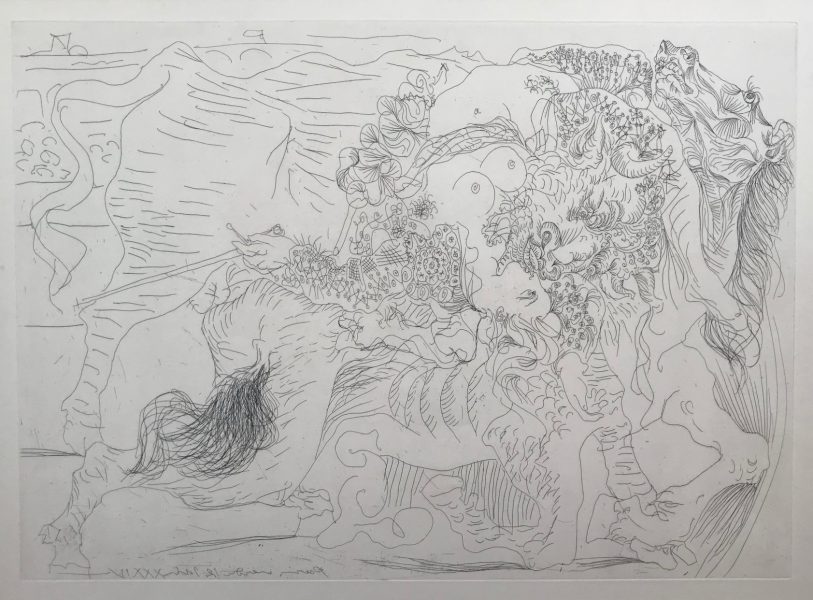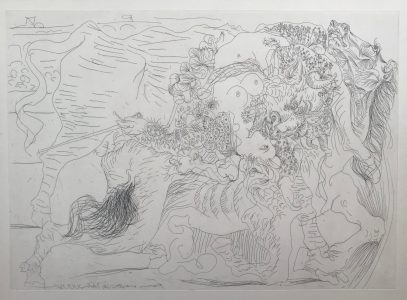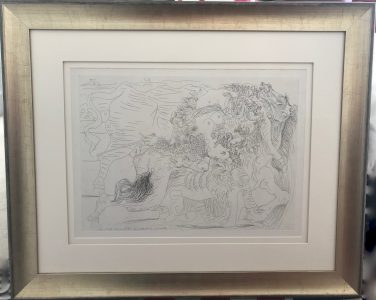Female Bullfighter, I: Last Kiss
Date: June 12, 1934, Paris
Medium: Etching on copper
Dimensions: P 495 x 695 mm, 19.5 x 27.4″; S 573 x 774 mm, 22.6 x 30.5″
Signature: The edition was unsigned apart from several proofs. (Note: There are known forged signatures)
Selected References:
Bloch 1329; Baer 425C, OPP34:068.
Rubin, William S., ed. Pablo Picasso: A Retrospective. New York: Museum of Modern Art Graphic Society, 1980, p. 319 .
Fryberger, Picasso Graphic Magician: Prints from the Norton Simon Museum, p.129.
Blunt, Anthony. Picasso’s “Guernica”. New York: Oxford University Press, 1969, ill. 6b.
Chipp, Herschel B. Picasso’s Guernica: History, Transformations, Meanings. California Studies in the History of Art. No 26, 1988, ill. 5.16.
Clair, Jean, ed. Picasso Érotique. New York: Prestel, 2001; p. 178.
Ullmann, Ludwig. Picasso und der Krieg. Bonn: Karl Kerber Verlag, 1993, p. 66.
Bernadac, Marie-Laure, Brigitte Léal & María Teresa Ocaña. Picasso: Toros y Toreros. Barcelona: Museu Picasso, 1993, p. 76.
Speyer, James A. & Dennis Adrian. Picasso in Chicago: Paintings, Drawings and Prints from Chicago Collections. Chicago: The Art Institute of Chicago, 1968, p. 140.
Laniado-Romero, Bernardo, ed. Picasso: Toros. Málaga: Museo Picasso, Málaga, 2005, p. 58.
Edition: Of the unsigned and unnumbered edition of 50 printed by Lacourière in April, 1939.
Paper: Montval laid; with full margins and deckled edges on all sides
Watermark: Montval
Provenance:
The artist’s collection
Gallery Bayeler
Private collection: Sydney, Australia
Impression: A fine, pre-steelfacing impression (there was no steelfacing on this copper)
Condition: Fine. There are a few tiny, unobtrusive foxmarks in the margins, and the sheet is slightly light-struck, as only discernible by contrast to the minimally paler peripheral margins (due to previous over-matting); framed.
Price: Upon request
Picasso created five prints which Bloch names Femme Torero over a ten-day period. This is by far the largest of them and without a doubt one of the three most beautiful and poignant. (In fact, it is one of Picasso’s largest prints, and I believe it is his second largest etching, about an inch shorter than La Femme qui Pleure [B1333].) Including the closely related La Grande Corrida, all of them depict a bull and Picasso’s mistress Marie-Thérèse Walter as a female bullfighter who has fallen off her gored horse. This series of prints presages Guernica both stylistically and thematically. Most of them, including this print, are highly successful works, beautiful to behold and laden with symbolism. In my estimation, lyrically and artistically they lead the pack of Picasso’s many takes on the corrida, although I also favor a couple of the linocuts on this subject.
The bullfighter in all six prints looks enraptured, despite her tumble. Femme Torero, I touchingly portrays the bull and torera, who, with locked gazes, are oblivious to the anguish of the wounded horse beside them. In this first print of the series, the woman and bull seem about to kiss on the lips. As if to leave no doubt, Picasso here has endowed the bull with human-shaped lips. This liaison could also be interpreted as the kiss of death, given the ambiguity of the series as to whether the torera is still alive. As Marilyn McCully has pointed out in, this interpretation could be supported by, and symbolic of, the fact that Picasso’s passion for Marie-Thérèse was drawing to an end.
It is widely agreed that Picasso identified with the bull, which more generally symbolized maleness and virility. Much has been written about the bullfight as a stylized sexual encounter. It is perhaps less well know that there was a famous female bullfighter with whom Picasso was acquainted. I am uncertain if he knew her and if she were active at this time, or only later as recounted by Francoise Gilot.


